Overview
This article provides a comprehensive step-by-step guide on how to successfully execute on-premise to cloud migration. Are you ready to transform your organization’s operational efficiency? It emphasizes the critical need to:
- Assess current systems
- Define clear migration goals
- Select appropriate service models
Furthermore, it addresses significant challenges such as:
- Data security
- Cost overruns
By following this structured approach, organizations can enhance their operational efficiency and ensure a successful transition to cloud environments. Don’t miss the opportunity to elevate your business—take action now and embrace the cloud.
Introduction
In the digital age, the transition from on-premise systems to cloud environments transcends mere trend; it stands as a strategic imperative for organizations seeking to boost agility, cut costs, and enhance operational efficiency.
As businesses navigate the intricate landscape of migration, grasping the nuances of cloud transition becomes essential.
This article explores the critical components of successful cloud migration, examining various strategies, best practices, and the substantial benefits that await organizations ready to embark on this transformative journey.
With insights from industry experts and real-world case studies, readers will uncover effective planning methods for their migration, address potential challenges, and harness powerful tools to facilitate a seamless transition to the cloud.
Understanding On-Premise to Cloud Migration: An Overview
The transition from on-premise to cloud environments involves a strategic transfer of data, applications, and IT resources from local servers to internet-based platforms. This migration empowers organizations to leverage the scalability, flexibility, and cost-effectiveness inherent in cloud computing. A solid understanding of the fundamental principles of this transition is essential for businesses aiming to modernize their IT infrastructure and enhance operational efficiency.
Key components of a successful migration include:
- Assessing Current Systems: Organizations must evaluate their existing IT landscape to identify which applications and data are suitable for migration. This assessment is crucial in understanding dependencies and potential challenges.
- Defining Migration Goals: Establishing clear objectives, such as improving performance, reducing costs, or enhancing security, is vital. These goals guide the migration strategy and help measure success.
- Selecting Appropriate Service Models: Businesses can choose from various service models, including Infrastructure as a Service (IaaS), Platform as a Service (PaaS), and Software as a Service (SaaS), depending on their specific needs and capabilities.
Current trends indicate that 80% of businesses are now utilizing hybrid solutions, reflecting a growing preference for flexible integration of on-premise to cloud migration and online resources. However, challenges persist; high costs, lack of visibility, and insufficient expertise continue to hinder the adoption of this technology. Notably, a recent report revealed that 32% of budgets for online services are wasted, an increase from 30% in the previous year, underscoring the need for careful planning and execution.
Expert insights highlight the significance of grasping the principles of transitioning to online services. As noted by industry leaders, a successful transition requires not only technical expertise but also a deep understanding of industry-specific needs. For example, Dimitar Stanev, a Solution Architect, emphasized that certified software developers with experience in fields such as healthcare and aviation can significantly expedite the transition process by reducing knowledge transfer time.
Case studies illustrate the effectiveness of cloud migration strategies. The Hybrid Integration Platform has been instrumental in assisting entities in regulated environments, such as banking and healthcare, to simplify complex integration projects. Since its inception, the company has successfully implemented hybrid integration solutions, notably with Coast Capital, where the platform facilitated major system transitions with minimal downtime.
By addressing the challenges of high costs, lack of visibility, and insufficient expertise, the company enables organizations to navigate their migration journeys more effectively. Customers have praised the company for delivering results within desired time frames and budget constraints, ultimately enhancing operational capabilities and reducing costs. One customer stated, “Avato’s platform not only streamlined our processes but also significantly cut our operational costs, allowing us to focus on growth.”
In summary, the advantages of transitioning to an online environment are substantial, including improved scalability, decreased operational expenses, and increased agility. By understanding the principles and utilizing expert insights, organizations can effectively manage the complexities of on-premise to cloud migration, ensuring a successful transition that positions them for future growth.
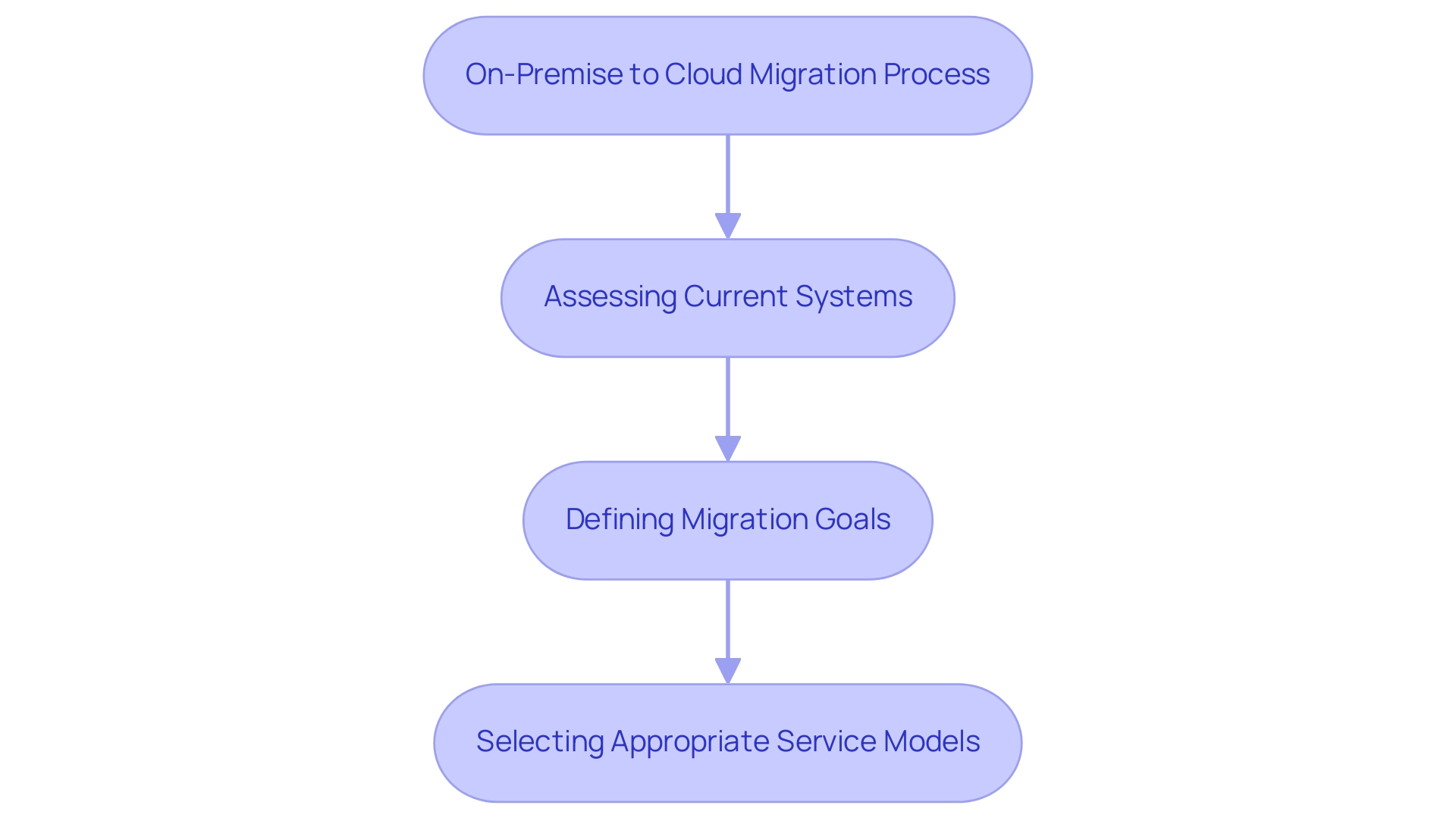
Key Benefits of Migrating to the Cloud
The benefits of transitioning from on-premise to cloud migration can significantly transform business operations. Key advantages include:
- Cost Efficiency: Shifting to online solutions reduces the necessity for extensive physical infrastructure and related maintenance expenses. This transition can lead to substantial savings, as organizations can allocate resources more effectively. In fact, recent statistics indicate that 39% of entities deploying a hybrid cloud strategy experience notable cost reductions, underscoring the financial benefits of moving from on-premise to the cloud. Avato’s hybrid integration platform further simplifies complex integrations, reducing costs associated with legacy systems and enhancing overall value.
- Scalability: Cloud environments empower businesses to effortlessly scale resources in response to fluctuating demand. This flexibility not only optimizes resource management but also ensures that organizations can adapt swiftly to market changes, enhancing their competitive edge. Significantly, 33% of organizations employ a multi-service approach for on-premise to cloud migration, leveraging various offerings and reflecting a growing preference for flexibility and risk mitigation in deployments. The platform supports this scalability with its robust architecture designed for 24/7 uptime, ensuring reliable integration for digital transformation initiatives.
- Enhanced Security: Numerous service providers offer advanced security features that may be prohibitively expensive for on-premise solutions. With 46% of European companies storing all their data in online storage and 43% classified as sensitive, leveraging security measures can significantly mitigate risks associated with data breaches and compliance issues. The platform is architected for secure transactions, making it a trusted choice for sectors like banking, healthcare, and government.
- Improved Collaboration: Cloud platforms facilitate seamless remote access, enabling teams to collaborate effectively regardless of their physical location. This capability enhances productivity and fosters innovation, as employees can work together in real-time on shared projects. The integration solutions provided enhance collaboration by unlocking isolated assets and enabling connected customer experiences.
- Disaster Recovery: Robust backup and recovery options are typically included in online solutions, ensuring data integrity and availability. This feature is crucial for maintaining business continuity, particularly in sectors where data sensitivity is paramount. Avato’s commitment to providing a robust base for digital transformation projects guarantees that companies can depend on efficient disaster recovery plans.
As enterprises increasingly acknowledge these advantages, the movement towards on-premise to cloud migration continues to expand. In 2025, experts forecast that companies adopting computing services will not only improve their operational efficiency but also gain a strategic edge in managing the complexities of the digital environment. Additionally, it is important to note that 4 out of 10 companies cite skill shortages as a top factor impacting their multi-cloud operations, underscoring the challenges organizations face in this transition.
As Gustavo Estrada, a client, remarked, the company simplifies intricate projects and delivers outcomes within preferred timelines and financial limits, further emphasizing the significance of selecting the appropriate integration partner in the transition. Avato’s hybrid integration platform, with its support for 12 levels of interface maturity, empowers businesses to future-proof their operations through seamless data and system integration.
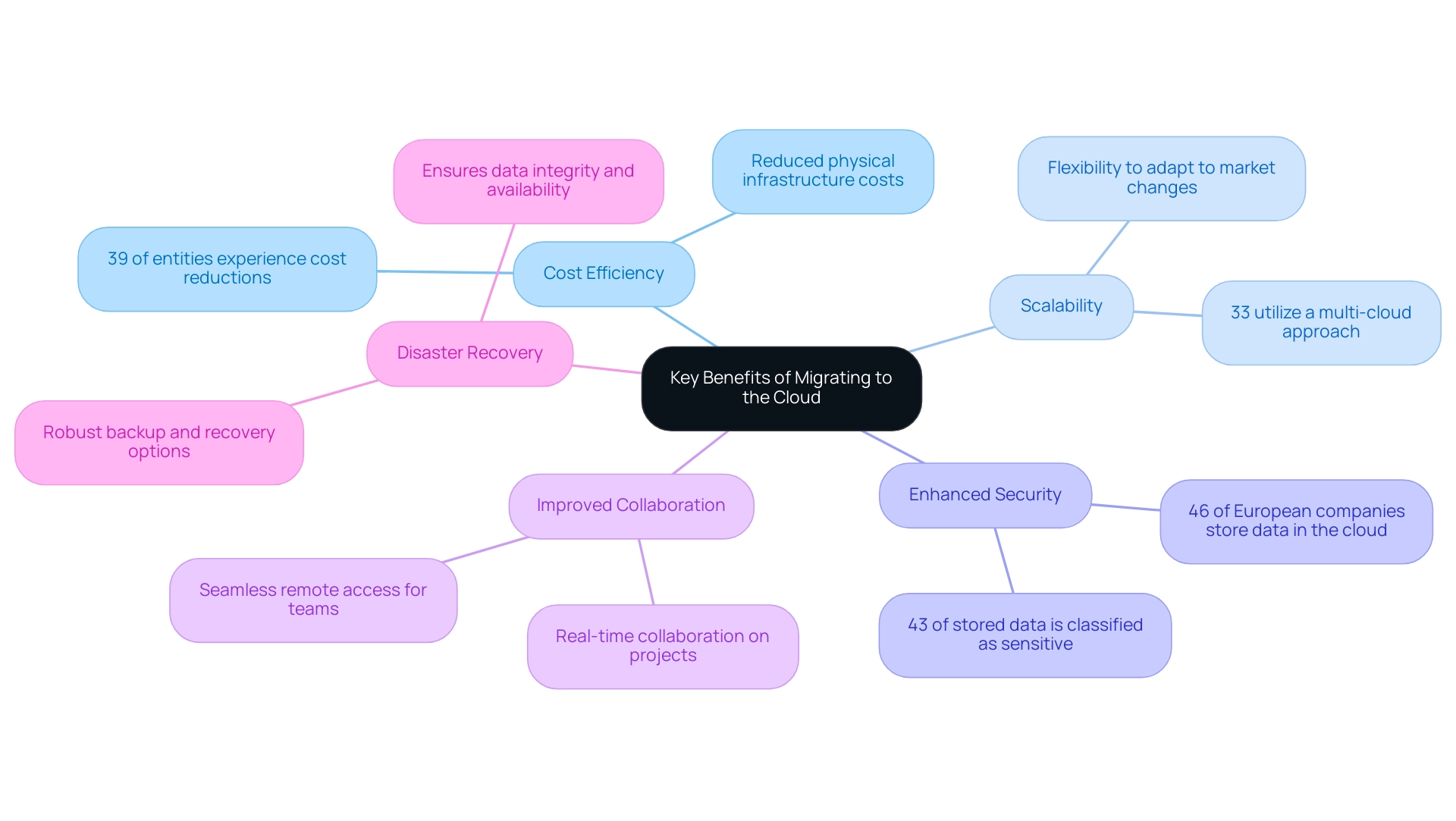
Exploring Different Approaches to Cloud Migration
When contemplating the transition to remote servers, organizations can select from various strategic methods, each with its unique benefits and factors to consider:
- Rehosting (Lift-and-Shift): This approach entails relocating applications to the remote environment without implementing substantial changes. It is frequently the quickest approach for migration, enabling businesses to swiftly shift to digital infrastructure. However, while it facilitates immediate deployment, it may not fully capitalize on the advanced capabilities offered by online environments.
- Replatforming: This method involves making minimal adjustments to applications to optimize them for the online infrastructure. By balancing speed with efficiency, replatforming enables enterprises to enhance performance without the extensive resource investment required for a complete overhaul.
- Refactoring: Refactoring involves redesigning applications to leverage cloud-native features fully. This method can significantly enhance performance and scalability but requires more time and resources, making it suitable for organizations aiming to maximize their investment in the infrastructure.
- Retiring: In this strategy, organizations decommission applications that are no longer necessary. This not only simplifies the transition process but also aids in lowering costs linked to maintaining outdated systems.
- Retaining: Some applications may need to remain on-premise due to specific compliance requirements or performance considerations. This method enables companies to transfer specific systems while retaining others in their initial environment, ensuring that essential legacy systems remain functional.
As strategies for moving to the new environment develop, the success rates of these methods differ. Recent statistics indicate that organizations employing a lift-and-shift strategy often experience quicker transitions, yet they may face challenges in optimizing their usage of the platform. In contrast, refactoring, while more resource-intensive, tends to yield higher long-term benefits by enhancing application performance and scalability.
Expert opinions in 2025 highlight the importance of aligning migration strategies with business objectives. IT leaders emphasize that a well-planned approach can significantly influence the overall success of digital initiatives. For instance, a case study from 2021 revealed that 70% of Nigerian government agencies relied on international online services, showcasing a growing trend towards on-premise to cloud migration in regions previously dependent on on-premise solutions. This change highlights the necessity for enterprises to adjust their strategies regarding on-premise to cloud migration to stay competitive in a progressively digital environment.
Furthermore, with significant online service providers such as Amazon Web Services, Microsoft Azure, and Google Cloud Platform representing 66% of worldwide expenditure at the end of 2022, comprehending the competitive environment is essential for banking IT managers. In conclusion, choosing the appropriate online transition strategy is vital for entities looking to modernize their operations. By grasping the nuances of each method, businesses can make informed choices that align with their objectives and ensure a successful transition to the digital environment.
The dependable hybrid integration platform, crafted for continuous availability and able to streamline intricate integrations, aids these initiatives, allowing organizations to manage their transition efficiently. The platform also supports 12 levels of interface maturity, allowing businesses to balance speed of integration with the sophistication required to future-proof their technology stack. As Gustavo Estrada pointed out, the platform streamlines intricate projects and provides outcomes within preferred timelines and financial limits, establishing it as a significant ally in the transition process.
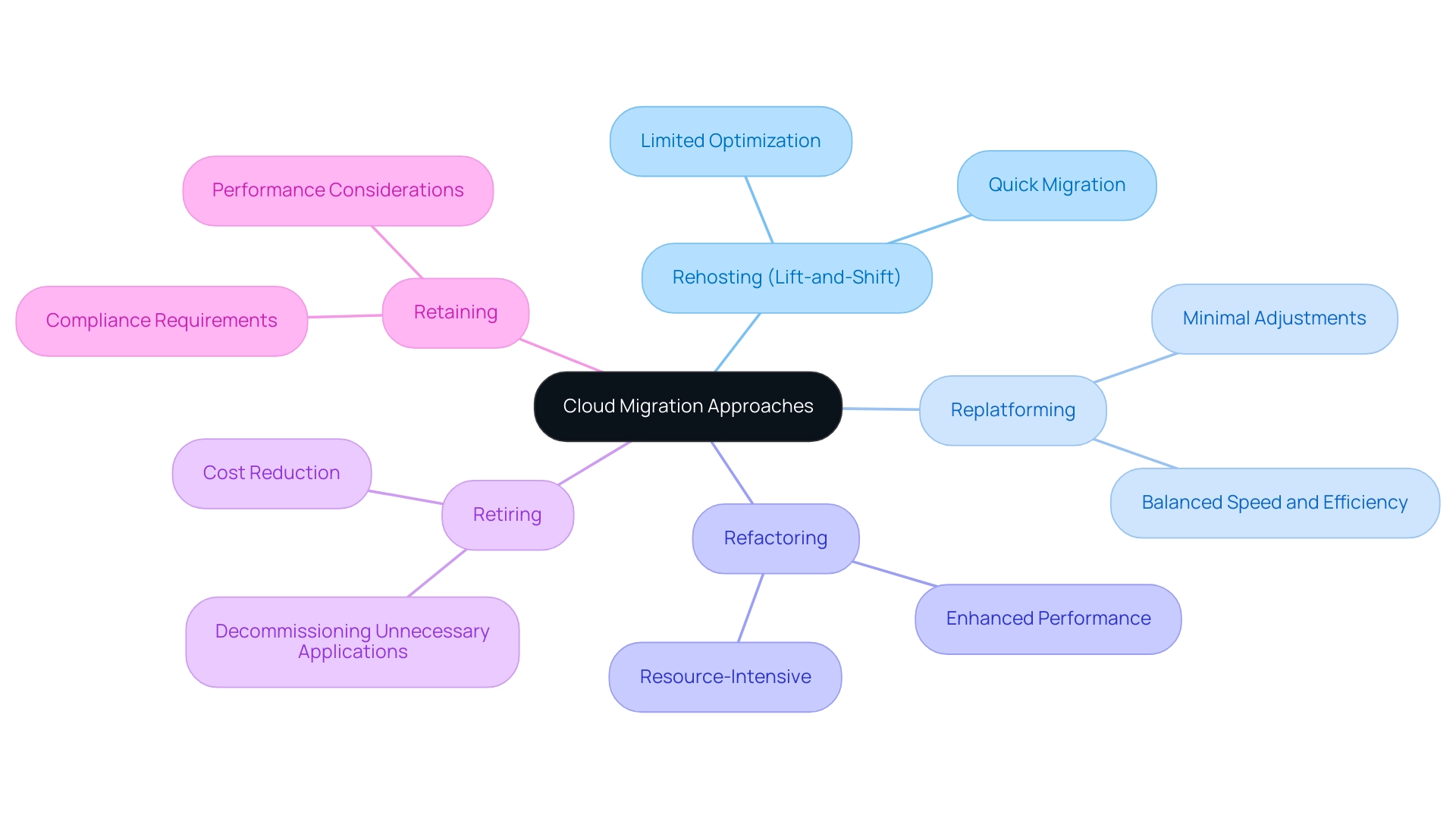
Step-by-Step Guide to Planning Your Migration
To effectively plan your migration to the cloud, follow these essential steps:
- Assess Current Infrastructure: Begin with a thorough evaluation of your existing systems, applications, and data. This assessment will identify what needs to be migrated in the transition from on-premise to cloud and highlight any potential compatibility issues. Leveraging Avato’s Hybrid Integration Platform can streamline this evaluation process, ensuring a comprehensive understanding of your infrastructure through features like automated discovery and compatibility analysis.
- Define Objectives: Establish clear and measurable goals for the migration. Common objectives of on-premise to cloud migration include achieving cost savings, enhancing performance, and improving security. With 98% of companies utilizing online services, aligning your goals with industry standards is crucial. Avato’s solutions can help set benchmarks that reflect best practices in digital transformation, utilizing analytics tools to track progress against these objectives.
- Choose a Service Provider: Select a service provider that meets your business needs and compliance requirements. Leading providers, such as Amazon Web Services, Microsoft Azure, and Google Cloud Platform, accounted for 66% of global cloud spending at the end of 2022, reflecting their dominance and reliability in the market. Avato can assist in evaluating these options for on-premise to cloud migration to find the best fit for your entity, providing comparative analysis tools to assess provider capabilities.
- Develop a Migration Strategy: Formulate a comprehensive strategy for on-premise to cloud migration based on your assessment and objectives. Consider various approaches, such as lift-and-shift or refactoring, to determine the best fit for your organization. The company’s expertise in hybrid integration can guide you in selecting the most effective strategy for integrating legacy systems, with features that support both real-time and batch processing.
- Create a Timeline: Establish a realistic schedule for the transition process, incorporating key milestones and deadlines. This organized method assists in managing expectations and ensures that the on-premise to cloud migration transition remains on schedule, with project management tools aiding in timeline development and modification.
- Engage Stakeholders: Involve key stakeholders throughout the planning process. Their insights and support are crucial for ensuring alignment and addressing any concerns that may arise during the on-premise to cloud migration process. Avato encourages collaboration among stakeholders through its platform, which includes communication tools and shared dashboards to keep everyone informed and engaged.
- Test and Validate: Before executing the complete transfer, perform comprehensive testing to confirm your transfer plan. This step is essential for identifying and resolving potential issues during on-premise to cloud migration, thereby minimizing disruptions during the actual transition. Utilizing Avato’s tools can enhance the testing phase, ensuring a robust transition plan with features for automated testing and validation.
In 2025, organizations will encounter considerable obstacles in transitioning to online services, with 84% citing the management of spending related to these services and 77% emphasizing security as key concerns. Tackling these challenges is crucial for efficient management of online services. Companies are ramping up cloud security while optimizing their cloud spending, underscoring the importance of these aspects in the on-premise to cloud migration.
Successful planning examples, such as those from BC Provincial Health Services Authority, demonstrate how organizations can simplify complex projects and achieve results within desired time frames and budget constraints. As Gustavo Estrada noted, “Avato has simplified complex projects and delivered results within desired time frames and budget constraints,” illustrating how effective solutions can address these challenges. By adhering to these best practices and utilizing expert guidance, businesses can manage the intricacies of digital transition with assurance.
For a visual summary of these steps, refer to the infographic on successful digital transformation.
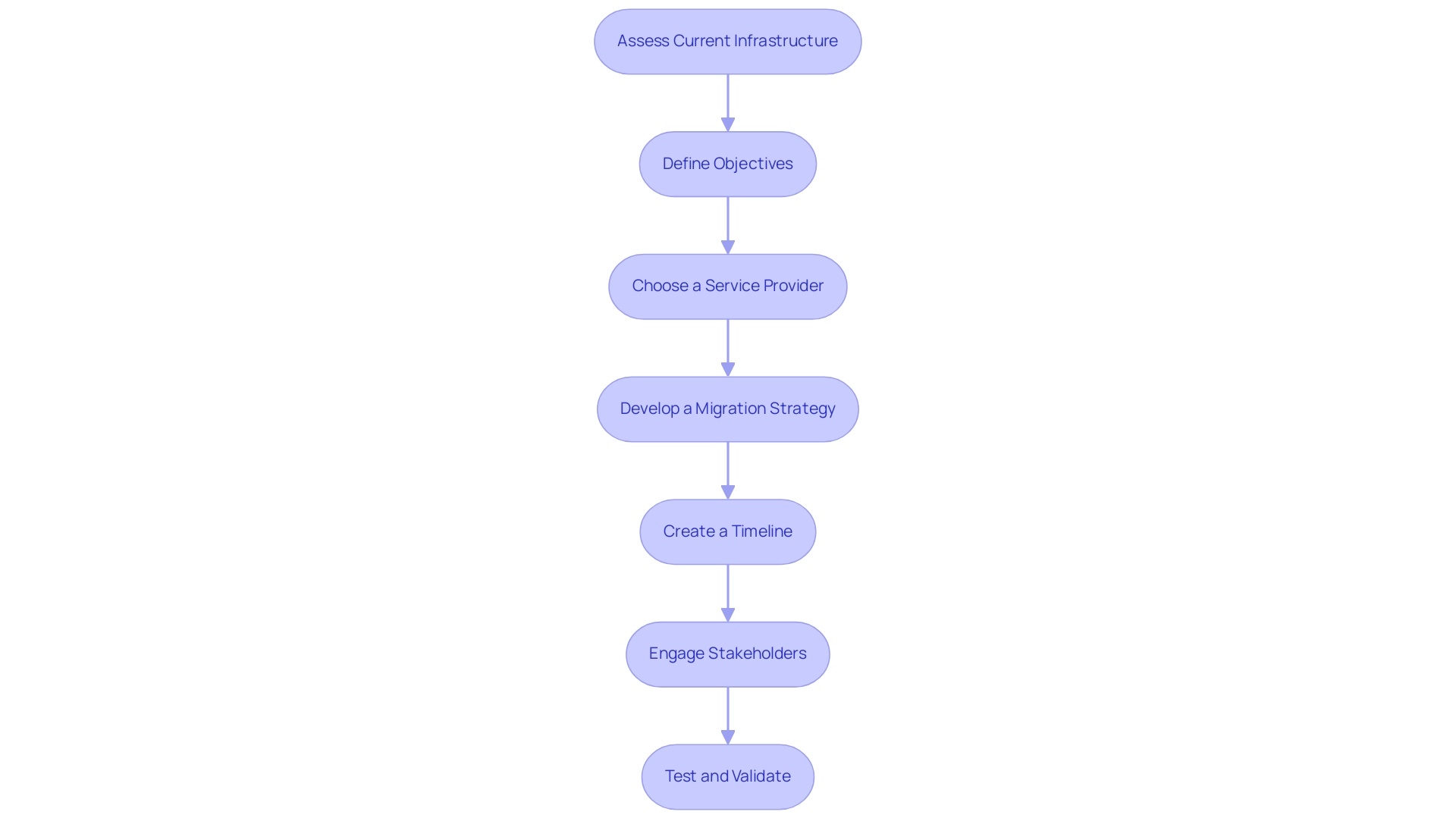
Navigating Challenges in On-Premise to Cloud Migration
Organizations embarking on the journey of on-premise to cloud migration encounter a range of challenges that can significantly impact their success. Key challenges include:
- Data Security Concerns: Safeguarding data integrity and ensuring compliance with regulatory standards is paramount, particularly in sectors such as banking and healthcare. A staggering 69% of companies express anxiety over potential data loss and leakage during transition, while 93% are concerned about human error leading to accidental exposure. This emphasizes the critical need for robust security measures throughout the on-premise to cloud migration process. The hybrid integration platform is designed for secure transactions, trusted by banks, healthcare, and government, providing a rock-solid foundation for your digital transformation initiatives. Notably, a significant percentage of data breaches stem from human elements, such as credential theft and social engineering, emphasizing the need for comprehensive training and awareness programs for employees to mitigate these risks. As Tony Leblanc from the Provincial Health Services Authority noted, “Good team. Good people to work with. Extremely professional. Extremely knowledgeable.”
- Downtime Risks: Minimizing downtime is essential to maintain business continuity during on-premise to cloud migration. The impact of downtime can be severe, affecting customer service and operational efficiency. Organizations must implement strategies to ensure that critical systems remain operational, thereby mitigating the risks associated with service interruptions. Avato accelerates the integration of isolated systems and fragmented data, delivering the connected foundation enterprises need to simplify, standardize, and modernize their operations.
- Complexity of Legacy Systems: Integrating legacy systems with contemporary online solutions presents a significant challenge. Numerous entities discover that their current systems are not easily compatible with cloud technologies, which emphasizes the need for specialized expertise in on-premise to cloud migration to navigate these complexities. Avato’s platform supports 12 levels of interface maturity, allowing businesses to balance speed of integration with the sophistication required to future-proof their technology stack. This integration process can be time-consuming and requires careful planning to avoid disruptions.
- Cost Overruns: Unforeseen costs can occur during the transfer process, making it essential for entities to create a clearly outlined budget and backup plans. With enterprise online spending expected to rise by 29% in the next year, companies must be attentive in controlling expenses to prevent budget excesses that could disrupt their transition efforts. Avato’s committed method to integration aids in simplifying processes, potentially lowering expenses related to intricate transitions.
- Skill Gaps: The shift to online technology often uncovers skill deficiencies within companies. Many IT teams may lack the necessary expertise for effective cloud transition, prompting the need for training or the hiring of specialized personnel. Notably, 30% of IT professionals indicate that end-users are primarily responsible for ensuring the security of SaaS applications within their companies. Addressing these skill gaps is vital to ensure a smooth and successful on-premise to cloud migration. Avato’s team of integration experts is available to support organizations in overcoming these challenges, ensuring that they are equipped with the knowledge and tools necessary for a successful transition.
Real-world examples illustrate these challenges vividly. For instance, the recent data breach at FBCS in February 2024, which revealed sensitive information of over 4 million individuals, highlights the critical significance of data protection during transitions to online services. Moreover, specialist views further strengthen these worries, emphasizing the importance of cultivating a culture of security consciousness among all staff to reduce risks during data transfer.
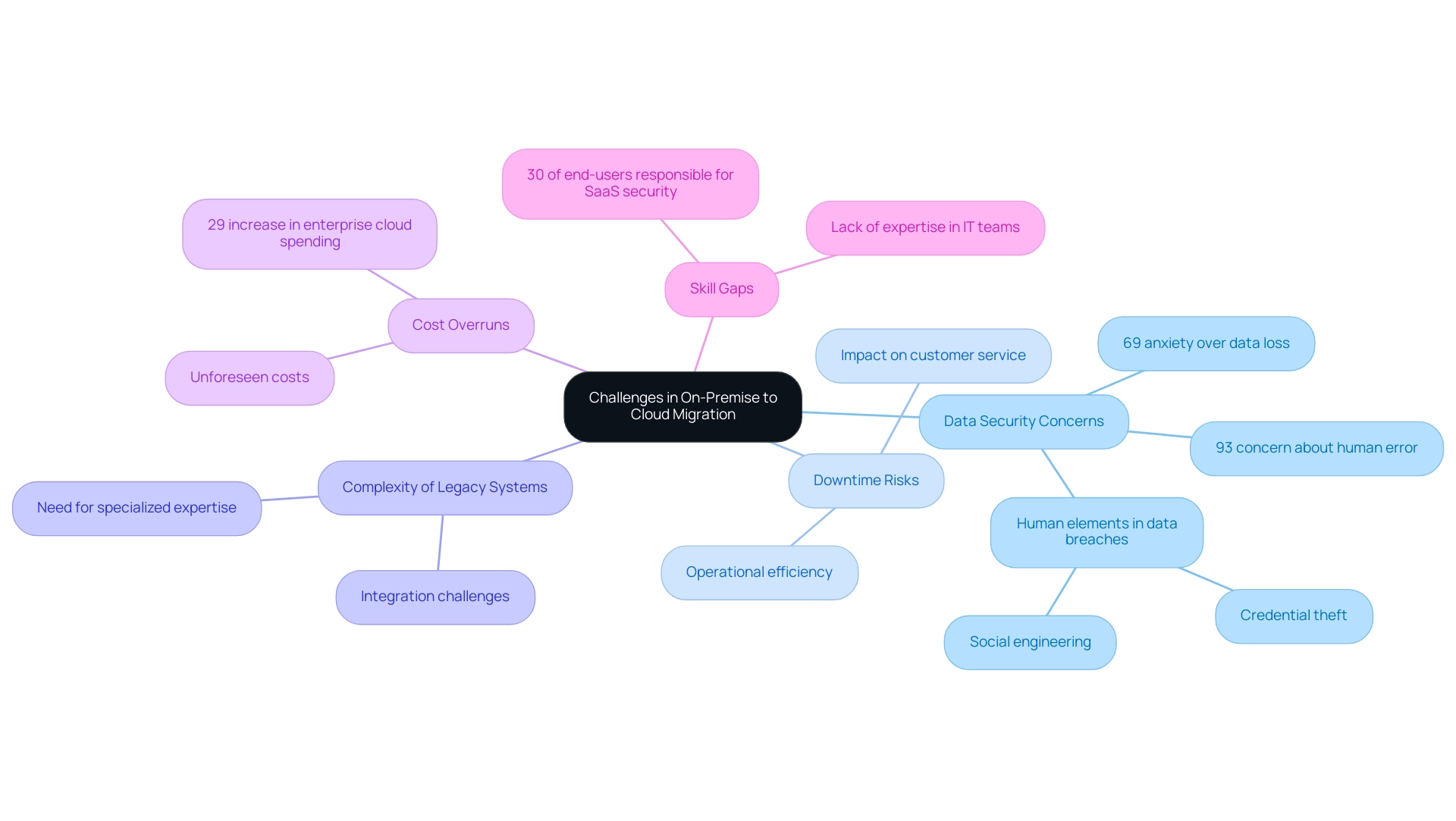
Ensuring Data Security and Compliance in Migration
- Conduct a Risk Assessment: Begin by identifying the potential security risks associated with the migration process. This involves evaluating existing vulnerabilities in your on-premise systems and understanding how these may be exacerbated during the transition to the cloud. The company’s phased implementation strategy allows for a gradual transition, minimizing risks and enabling adjustments based on feedback and performance. Develop comprehensive mitigation strategies to address these risks, ensuring that your organization is prepared for any challenges that may arise during the transition. Furthermore, utilize the real-time monitoring and alerts feature to stay informed about system performance and potential security threats.
- Implement Encryption: Encryption is a vital aspect of data protection during the online transition. Utilize strong encryption protocols for data both in transit and at rest. This practice safeguards sensitive information from unauthorized access, significantly reducing the risk of data breaches. As entities increasingly transition to the cloud, the significance of strong encryption practices cannot be overstated, particularly with Avato’s secure hybrid integration platform guaranteeing 24/7 uptime and reliability for complex systems in banking, healthcare, and government.
- Establish Access Controls: To safeguard sensitive data during transfer, it is essential to limit access to authorized personnel only. Implement role-based access controls (RBAC) to ensure that only those who need to interact with specific data can do so. This minimizes the risk of accidental exposure or malicious access, which is a growing concern, as 93% of organizations express worry about human error leading to data breaches. Additionally, consider the statistic that 39% of respondents in South Korea had the lowest number of audit failures, highlighting the effectiveness of stringent access controls in maintaining compliance.
- Regularly Audit Compliance: Conducting regular compliance audits is vital to ensure that all regulatory requirements are met throughout the transition process. This includes adhering to industry standards and regulations relevant to your sector, such as GDPR for data protection or HIPAA for healthcare. Regular audits help identify compliance gaps and allow for timely corrective actions. The financial implications of insufficient online security are significant, as highlighted in the case study titled “Financial Impact of Security Breaches,” where the average cost of a security incident rose to $4.24 million. This underscores the necessity of robust security measures during the transition, which Avato’s solutions are designed to support, including maximizing and extending the value of legacy systems.
- Engage with Service Providers: Collaborate closely with your service providers to gain a thorough understanding of their security measures and compliance certifications. This partnership is essential for ensuring that the environment aligns with your organization’s security policies and compliance requirements. By utilizing the knowledge of your service provider, you can improve your overall security stance during the transfer. The company, for instance, provides a reliable, future-proof technology stack that can significantly simplify complex projects, as noted by Gustavo Estrada from BC Provincial Health Services Authority, who stated, “The organization has the ability to simplify complex projects and deliver results within desired time frames and budget constraints.”
In 2025, as organizations increasingly prioritize data security compliance in the process of transferring data, these strategies will be essential for mitigating risks and ensuring a successful transition.
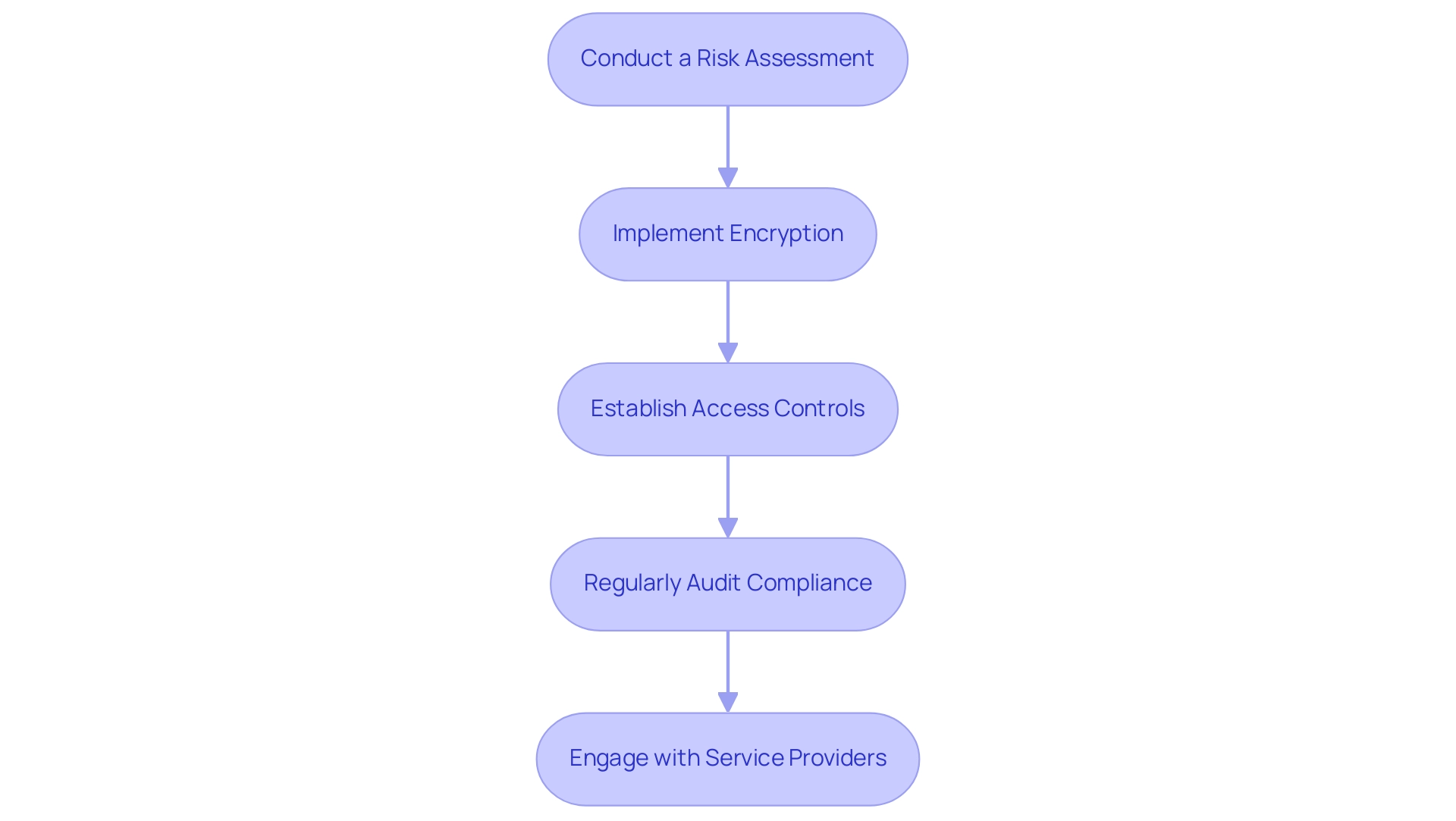
Best Practices for a Smooth Migration Experience
- Start Small: Begin your cloud transition journey with a pilot project utilizing Avato’s hybrid integration platform. This strategic approach allows you to test the on-premise to cloud migration process on a smaller scale, identifying potential challenges and refining your strategy before a full-scale rollout.
- Document Everything: Comprehensive documentation is essential. Maintain detailed records of the transfer process, including configurations, settings, and any modifications made. This documentation will serve as a valuable reference for troubleshooting and future transitions.
- Communicate Regularly: Effective communication is vital for a successful transition. Ensure that all stakeholders are kept informed throughout the process. Frequent updates facilitate alignment and enable the swift resolution of any issues that may arise.
- Monitor Performance: Leverage Avato’s robust analytics capabilities to track system performance during and after the transition. This proactive strategy allows for rapid recognition and resolution of problems, ensuring that the new online environment operates seamlessly and effectively.
- Plan for Post-Transfer Optimization: After the transfer is complete, take time to evaluate the new setting. Optimize configurations for both performance and cost-effectiveness, ensuring that your setup meets the evolving demands of your organization.
In 2025, the trend toward hybrid solutions and on-premise to cloud migration is expected to dominate strategies for transitioning services. This shift enables businesses to expand their strategies, preventing vendor lock-in while enhancing workloads. By adopting containerization as a primary transition strategy, organizations can decompose monolithic applications into microservices, increasing flexibility and scalability.
Practical examples of effective pilot projects demonstrate that entities implementing these best practices for on-premise to cloud migration can achieve higher success rates in their transition efforts, ultimately resulting in a smoother shift and enhanced operational capabilities. Furthermore, with over 600 investors and 750 startups showing interest in migration strategies, the landscape is rapidly evolving. As noted by Gustavo Estrada from BC Provincial Health Services Authority, Avato simplifies complex projects, which is crucial for organizations navigating these transitions.
The emergence of hybrid and multi-environment setups, as highlighted in the case study, underscores the importance of adopting diverse strategies to optimize workloads. Additionally, the partnership between Generative AI and internet-based computing is becoming a transformative trend, further emphasizing the necessity for businesses to stay informed about technological advancements. The company’s commitment to simplifying complex integrations is evident in its approach, and adhering to the five-step guide to successful digital transformation can significantly enhance your transition strategy.
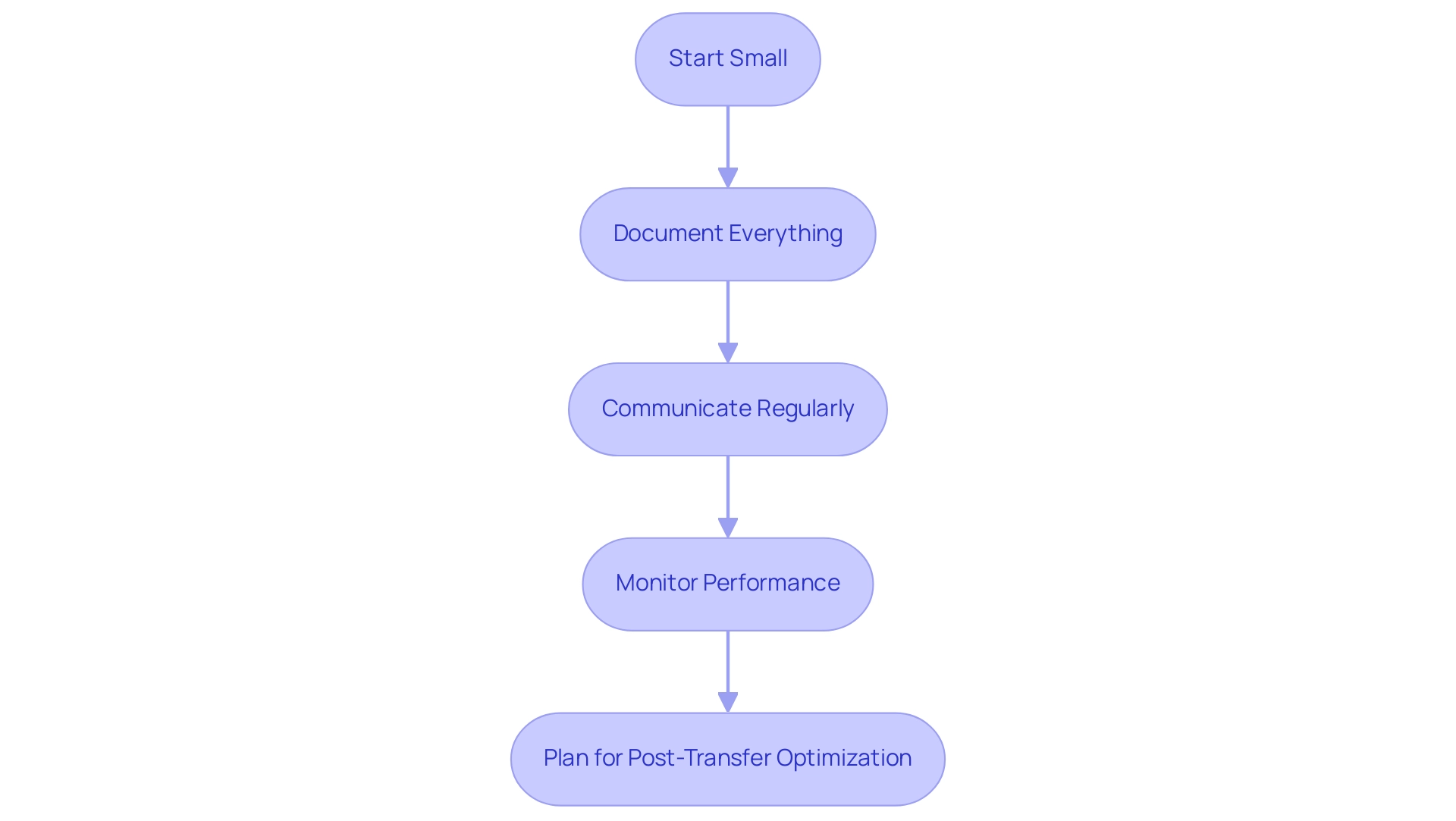
Essential Tools for On-Premise to Cloud Migration
Organizations aiming for on-premise to cloud migration can leverage several powerful tools designed to streamline the transition process and minimize risks. Key tools include:
- AWS Migration Hub: This tool serves as a centralized platform for tracking the progress of application transitions across various AWS services, providing visibility and control throughout the transition journey.
- Azure Migrate: A comprehensive suite of tools that assists in assessing, planning, and executing transitions to Microsoft Azure, ensuring that organizations can transition smoothly while optimizing their architecture.
- CloudEndure Migration: Known for its automation capabilities, CloudEndure minimizes downtime and disruption during the transition process, making it an ideal choice for businesses that require continuous operation.
- VMware HCX: This tool facilitates the seamless transition of VMware workloads to the environment, ensuring compatibility and performance, which is crucial for organizations with existing VMware setups.
- Datadog: Offering robust monitoring and analytics tools, Datadog helps track application performance during and after transitions, allowing organizations to quickly identify and address any issues that arise.
- Hybrid Integration Platform: This platform stands out as a key tool for organizations transitioning to the new environment, providing features such as real-time monitoring and rapid deployment. It simplifies the integration of isolated legacy systems and fragmented data, which is essential for minimizing risks during transition. The firm’s dedication to addressing intricate challenges is evident in its support for 12 levels of interface maturity, enabling businesses to balance speed and sophistication, ensuring a future-proof technology stack.
As online security remains a paramount concern—95% of companies express worries about it, with misconfiguration accounting for 68% of security issues—selecting the right tools is critical. Significant occurrences of data breaches during online transitions can result in financial losses frequently amounting to millions of dollars, highlighting the necessity for thorough planning and implementation. Avato’s platform addresses these security challenges by ensuring secure and reliable integration, which is vital for organizations in regulated sectors like banking.
The platform offers strong security measures that guarantee safe data connectivity during the migration process.
Expert opinions emphasize the significance of assessing existing configurations and selecting the finest services and tools provided by service providers. Dimitar Stanev, a Solution Architect, emphasizes that finding a middle ground between existing systems and online capabilities is essential for a successful on-premise to cloud migration.
Real-world examples demonstrate the effectiveness of these tools. For instance, organizations utilizing AWS Migration Hub have reported enhanced operational capabilities and reduced costs, as evidenced by case studies showcasing a hybrid integration platform. Clients such as John Johnstone from OSME Pacific and Gustavo Estrada from BC Provincial Health Services Authority have commended Avato for streamlining intricate integration projects and producing results within preferred timelines and budget limitations, further affirming the significance of choosing the appropriate transfer tools.
As companies progress on their digital journeys, utilizing these vital tools, including Avato’s hybrid integration platform, will be essential for attaining favorable results.

Key Takeaways and Next Steps for Successful Migration
Successful on-premise to remote transfer necessitates a strategic method that includes several essential elements:
-
Understanding Remote Transfer: Grasp the fundamentals of remote transfer, including its advantages such as cost reduction and improved scalability. For instance, companies like Applause have integrated platforms like CloudZero, resulting in a notable 23% decrease in cloud spending, underscoring the financial advantages of on-premise to cloud migration.
-
Choosing the Right Transition Strategy for On-Premise to Cloud Migration: Explore various approaches—such as lift-and-shift, re-platforming, or refactoring—for your on-premise to cloud migration and select the strategy that aligns best with your organization’s needs and capabilities. The dedicated hybrid integration platform simplifies the on-premise to cloud migration process by enabling seamless integration of diverse systems, ensuring that your transition strategy is both effective and efficient. By unlocking isolated assets, Avato enhances the overall migration experience related to on-premise to cloud migration, allowing for greater flexibility and improved operational efficiency.
-
Meticulous Planning: Develop a comprehensive migration plan that addresses potential challenges, including data security and compliance. With 50% of data anticipated to be stored online by 2025, ensuring robust security measures is paramount, especially as 43% of this data is classified as sensitive. This statistic emphasizes the urgency for organizations to adopt effective online strategies. The company’s expertise in designing technological foundations can help reduce these risks, demonstrating its strong commitment to achieving results for its clients.
-
Leveraging Best Practices and Tools for On-Premise to Cloud Migration: Utilize essential tools and best practices to facilitate a smooth transition experience. The IaaS market, which expanded by 29.7% worldwide in 2022, indicates the growing dependence on cloud services as a crucial element of effective on-premise to cloud migration strategies. The platform provides essential tools to support on-premise to cloud migration, unlocking isolated assets and boosting business value during this transition, reinforcing the company’s dedication to simplifying complex integrations.
Next Steps: Start by evaluating your current infrastructure and defining clear transition objectives. Involve stakeholders throughout your organization to develop a thorough transition plan that considers both technical and operational elements. The team of integration specialists can support you in this endeavor, ensuring that your migration aligns with your business goals.
Real-World Examples: Companies that have successfully undergone on-premise to cloud migration often report improved operational efficiency and reduced costs. For example, Gustavo Estrada from BC Provincial Health Services Authority noted that the system simplified complex projects, delivering results within desired time frames and budget constraints, emphasizing the importance of effective project management during on-premise to cloud migration.
Expert Insights: Industry leaders emphasize the importance of aligning on-premise to cloud migration strategies with business goals to ensure long-term success. Avato’s dedication to simplifying integration can play a crucial role in the alignment necessary for on-premise to cloud migration.
Statistics: As usage of online resources continues to rise, understanding the landscape is crucial. By 2025, total global data is anticipated to hit 200 zettabytes, highlighting the necessity for businesses to adjust their strategies accordingly.
By adhering to these guidelines and concentrating on strategic planning, organizations can effectively manage the intricacies of on-premise to cloud migration, ensuring a successful transition that enhances their operational capabilities. Avato, born from a commitment to solving complex problems, stands ready to support your on-premise to cloud migration journey.
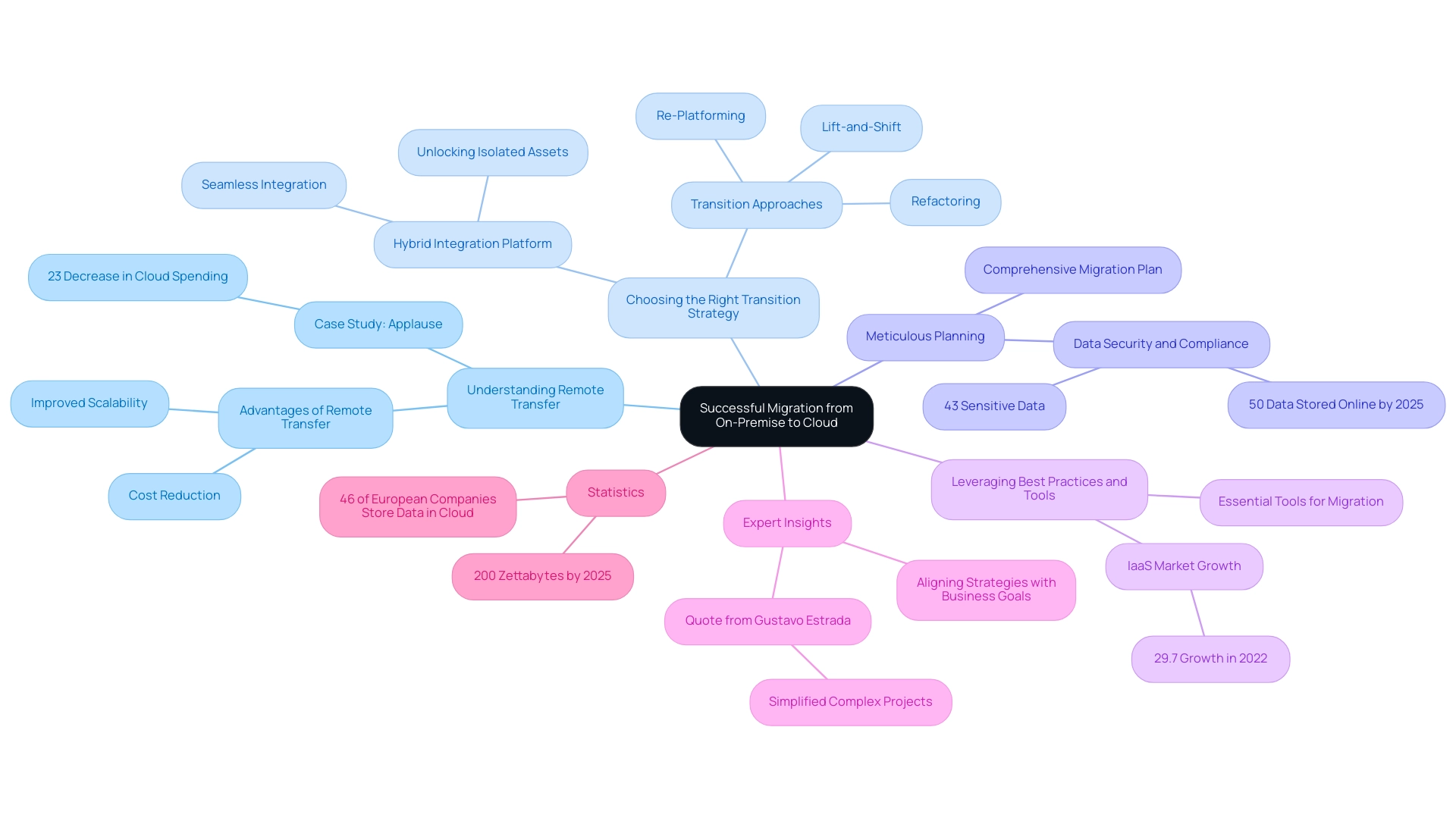
Conclusion
Migrating from on-premise systems to the cloud represents a transformative journey, offering a multitude of benefits for organizations ready to embrace this change. A successful cloud migration hinges on several key components:
- A thorough assessment of current systems
- The establishment of clear migration goals
- The selection of the most suitable cloud service models
By understanding the nuances of various migration strategies—such as lift-and-shift, replatforming, and refactoring—businesses can tailor their approach to align with specific operational needs and objectives.
The advantages of cloud migration are compelling. Cost efficiency, scalability, enhanced security, improved collaboration, and robust disaster recovery capabilities are just a few of the benefits that organizations are beginning to recognize. As these advantages become increasingly evident, many are adopting hybrid and multi-cloud strategies to optimize operations and maintain a competitive edge. However, challenges like data security concerns, downtime risks, and skill gaps must not be overlooked. Addressing these challenges through meticulous planning, the implementation of best practices, and leveraging essential tools is crucial for a seamless transition.
Looking ahead, organizations are encouraged to take proactive steps in their cloud migration journey. By assessing current infrastructure, defining clear objectives, engaging stakeholders, and utilizing expert insights and tools, businesses can navigate the complexities of migration with confidence. The commitment to simplifying integration, as exemplified by platforms like Avato, will play a pivotal role in ensuring that cloud migration not only meets immediate needs but also positions organizations for future growth and success in an increasingly digital landscape.

